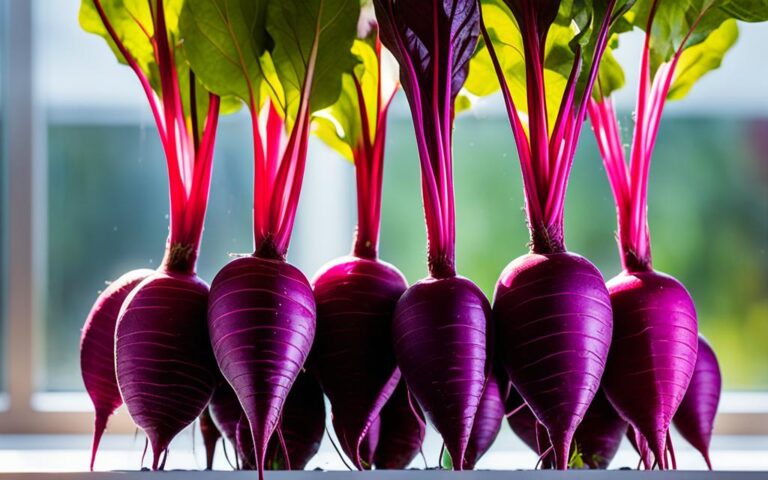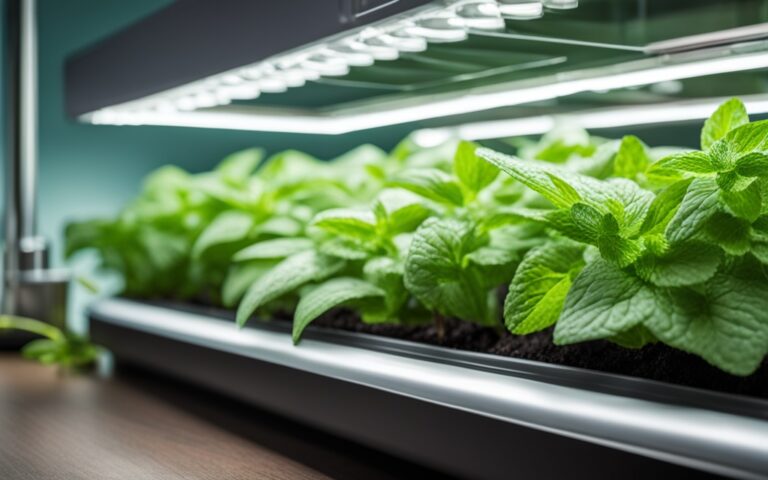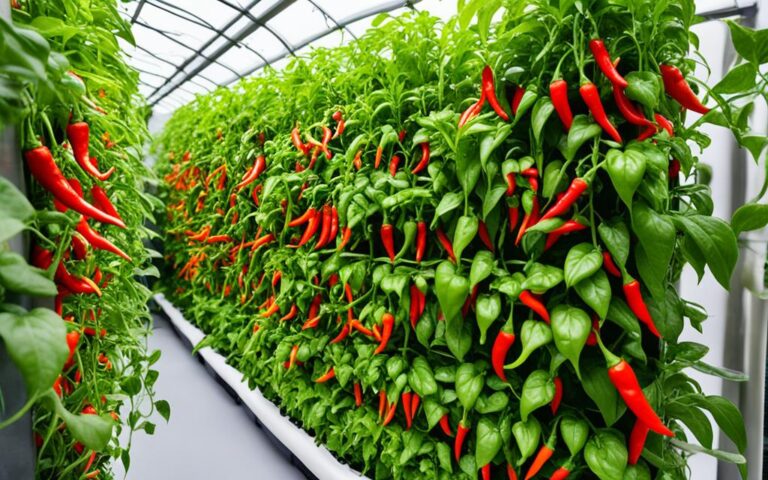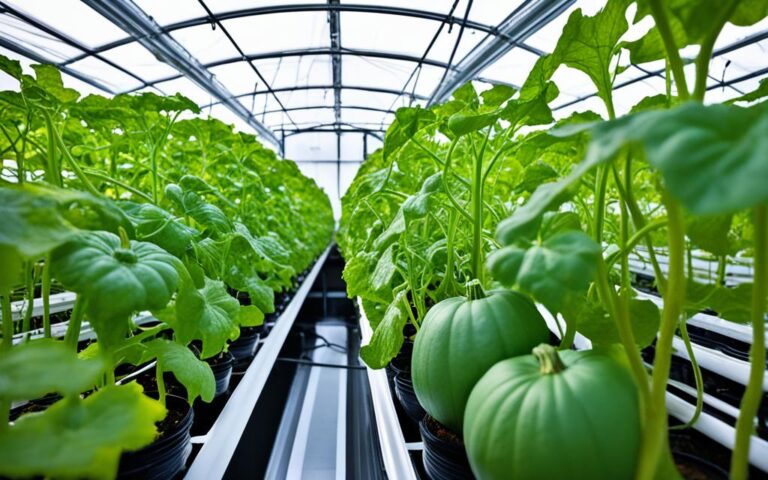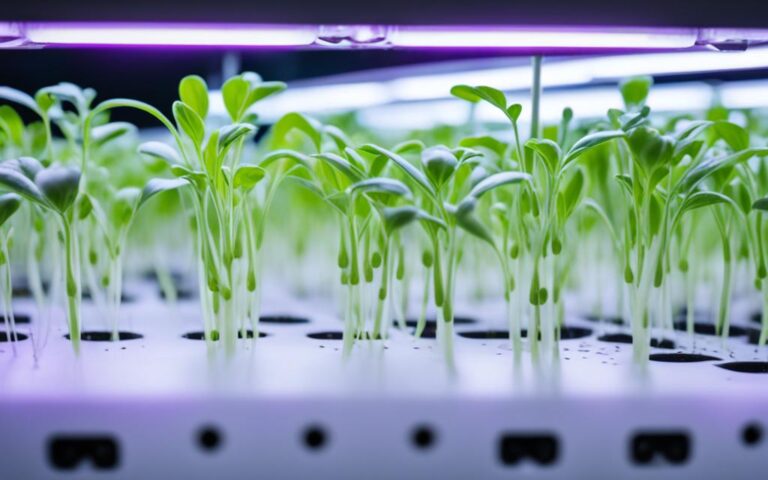Grow Hydroponic Scallions Successfully | Tips & Tricks
Did you know the global hydroponic market is set to hit $27.8 billion by 2025? This growth is fueled by the need for nutrient-rich produce all year round. Hydroponic scallions are leading this trend, adding flavor and versatility to kitchens everywhere.
This guide will give you the key tips and techniques for growing hydroponic scallions. It doesn’t matter if you’re new or experienced in hydroponics. You’ll learn how to pick the best system, increase your yield, and boost flavor. By the end, you’ll be able to grow healthy, nutrient-packed scallions at home.
Key Takeaways
- Hydroponic scallions offer a year-round harvest potential with a nutrient-rich, vitamin-packed profile.
- Choosing the right hydroponic system and understanding essential nutrient requirements are crucial for success.
- Monitoring and adjusting pH levels, lighting, temperature, and humidity are key to optimizing scallion growth.
- Proper planting and spacing techniques, as well as addressing common issues, can help maximize your hydroponic scallion yield and flavor.
- Scallions grown hydroponically can be used in a variety of delicious recipes, adding a fresh and versatile touch to your meals.
Introduction to Growing Hydroponic Scallions
Hydroponic scallions, also known as bunching onions, are a great choice for gardeners. They don’t grow big bulbs like regular onions. This makes them perfect for small spaces, from indoor gardens to big farms.
They grow well in hydroponic systems because they get all the nutrients they need from water. This means they grow faster and produce more. Plus, hydroponics keeps pests and diseases away, giving you a healthier crop.
| Hydroponic Scallions Overview | Benefits of Growing Scallions Hydroponically |
|---|---|
|
|
Learning about hydroponic scallions can help gardeners get the most out of this crop. With the right knowledge, you can enjoy a steady supply of fresh scallions all year long, whether at home or in a business.

Benefits of Growing Scallions Hydroponically
Growing scallions hydroponically has many advantages over traditional soil methods. One big plus is their high nutrient content.
Nutrient-Rich and Vitamin-Packed
Hydroponic scallions are a top nutrient-dense superfood. They are full of vitamins and minerals. You’ll find lots of vitamins K, C, and B2, plus minerals like calcium, iron, and potassium. This makes them a great choice for a healthy diet.
Year-Round Harvest Potential
Another big plus of hydroponic scallions is you can harvest them all year. The controlled environment lets you manage temperature, humidity, and nutrients. This means you can grow continuous harvest hydroponic scallions anytime, no matter the weather outside.
By using hydroponics, gardeners and producers can have a steady supply of fresh, tasty scallions all year. They also get to enjoy their high nutrient value.
“Hydroponic scallions are a true superfood, packed with essential vitamins and minerals that nourish the body.”
Selecting the Right Hydroponic System
Choosing the right hydroponic system is key to growing hydroponic scallions. Systems like deep water culture (DWC), ebb and flow, and nutrient film technique (NFT) work well for scallions. Each system has its own perks and things to think about, like water use, nutrient delivery, and how big you can grow.
Types of Hydroponic Systems for Scallions
Growers have many types of hydroponic systems for growing scallions to pick from, each with its own benefits:
- Deep Water Culture (DWC): This system keeps the plant’s roots in an oxygen-rich nutrient solution. It gives a steady supply of water and nutrients.
- Ebb and Flow: This method, also called the flood and drain system, floods the grow tray with nutrient-rich water at set times. The roots absorb what they need.
- Nutrient Film Technique (NFT): In this system, a thin stream of nutrient solution flows over the plant’s roots. It makes sure the roots get the essential elements they need.
Considerations for System Selection
When picking the best hydroponic system for scallions, think about these key points:
- Space requirements: Look at the space you have and pick a system that fits.
- Water and nutrient usage: Consider how efficient the system is with water and nutrients to use resources well.
- Scalability: Decide if the system can grow or be copied as your scallion operation gets bigger.
- Maintenance and automation: Check how easy the system is to maintain and if it can be automated. This helps make your hydroponic setup smoother.
By thinking about these factors, you can pick the ideal hydroponic system for growing scallions. This will meet your needs and help you get a great harvest.
Starting from Seeds vs. Transplants
Gardeners can start a hydroponic scallion garden from seeds or transplants. Each method has its own benefits and things to consider.
Growing from Seeds
Starting with seeds means germinating them and then moving the seedlings to the hydroponic setup. This way, you have more control over the growth. But, it takes more time and effort at first.
Scallion seeds take 2-4 weeks to grow into healthy plants ready for the hydroponics.
Using Transplants
Another option is to use pre-started scallion transplants. This saves time on germination and seedling growth. It means you can start your hydroponic garden faster.
But, finding good transplants can be hard. It also limits the types of scallions you can grow.
| Hydroponic Scallions from Seeds | Hydroponic Scallions from Transplants |
|---|---|
|
|
Choosing between seeds or transplants for your hydroponic scallions depends on what you prefer and your growing needs. Both ways can lead to a great harvest if you take good care of your plants.
Essential Nutrients for Hydroponic Scallions
To grow healthy hydroponic scallions, you need the right mix of nutrients. Scallions require specific nutrients for growth and a good yield. This includes both macronutrients and micronutrients.
Nutrient Solution Preparation
Getting the right hydroponic scallions nutrients is key. You must mix the nutrients correctly. This means adding the right amounts of nitrogen, phosphorus, potassium, and more.
- Nitrogen (N) for foliage development
- Phosphorus (P) for root growth and flowering
- Potassium (K) for overall plant vigor and stress resistance
- Calcium, magnesium, and trace minerals for various metabolic functions
The nutrient requirements for hydroponic scallions change with growth and the system used. Always check the nutrient solution and adjust it as needed. This keeps the nutrients in balance.
To make the nutrient solution for hydroponic scallions, mix the fertilizer with water. Make sure the pH is right and check the EC for the correct nutrient level. A good nutrient plan helps your hydroponic scallions grow well.
Monitoring and Adjusting pH Levels
Keeping the right pH level is key for growing hydroponic scallions well. The best pH for scallions in hydroponics is between 5.5 and 6.8. It’s important to check and adjust the pH in your system for healthy scallion growth.
The importance of pH in hydroponic scallions is huge. Scallions do best in a slightly acidic setting. This lets them take in the nutrients they need from the water. If the pH is off, it can cause nutrient shortages, slow growth, and health problems.
How to Maintain Proper pH for Hydroponic Scallions
To maintain the proper pH for hydroponic scallions, here’s what to do:
- Check the pH of your hydroponic solution often with a digital pH meter or test strips.
- If it’s too low (acidic), add a bit of pH-raising stuff like potassium hydroxide or calcium carbonate to fix it.
- If it’s too high (alkaline), use a pH-lowering stuff like phosphoric acid or sulfuric acid to adjust it.
- Change things a little at a time, big changes can upset the plants and cause more problems.
- Keep an eye on the pH as it can change for many reasons, like nutrient uptake, water changes, and plant growth.
By keeping a close eye on and adjusting the pH levels in your hydroponic scallion setup, you help make sure nutrients are available. This lets your scallions grow well.
Lighting Requirements for Optimal Growth
Good lighting is key for healthy growth and high yields in hydroponic scallions. They need about 16 hours of light daily for the best growth. Choosing the right grow lights and setting up your lighting correctly is crucial for a thriving garden.
Types of Grow Lights for Scallions
There are several grow light options for hydroponic scallions. Here are some top picks:
- LED Grow Lights – LED lights save energy, last long, and give scallions the right light spectrum for growth.
- Fluorescent Grow Lights – Fluorescent lights are budget-friendly and great for growing scallions hydroponically.
- HID (High-Intensity Discharge) Grow Lights – HID lights, like HPS or MH, give a wide spectrum of light and work well for scallions.
When picking grow lights for your scallion setup, think about energy use, light spectrum, coverage, and heat. This will help you choose the best lights for your needs.
“Proper lighting is key to growing healthy, high-yielding hydroponic scallions. The right grow lights can make all the difference in your success.”
| Grow Light Type | Pros | Cons |
|---|---|---|
| LED Grow Lights | Energy-efficient, long-lasting, optimal light spectrum | Higher initial cost |
| Fluorescent Grow Lights | Affordable, suitable for scallion growth | Lower energy efficiency, shorter lifespan |
| HID Grow Lights | Broad light spectrum, high intensity | Higher energy consumption, generate more heat |
Temperature and Humidity Control
Keeping the right temperature and humidity is key for growing hydroponic scallions. Scallions love a cool, moist place to grow well and reach their best.
The best temperature for hydroponic scallions is between 60°F and 75°F. This cool weather is what scallions naturally prefer. It helps them grow strong and taste great. Temperatures outside this range can cause scallions to grow poorly, get sick, or not taste good.
Humidity is also crucial for scallions. They need a humidity of 50-70%. This keeps them safe from fungal diseases and wilting. It also lets them breathe and take in nutrients properly.
| Parameter | Optimal Range | Potential Issues |
|---|---|---|
| Ideal Temperature | 60°F – 75°F | Stunted growth, disease, poor quality |
| Optimal Humidity | 50% – 70% | Fungal infections, wilting |
By keeping the ideal temperature for hydroponic scallions and optimal humidity for hydroponic scallions, you can make the perfect climate control for growing hydroponic scallions. This ensures your plants grow well from start to finish.
“Consistent climate control is the key to bountiful hydroponic scallion harvests.”
Planting and Spacing Techniques
To get a great hydroponic scallion harvest, you need the right planting and spacing methods. Here are some tips to help you:
Planting Density
For planting hydroponic scallions, put 16-25 seeds or transplants per square foot of space. This close planting makes for a lush, even canopy and boosts your yield in a small hydroponic setup.
Plant Spacing
Keep your hydroponic scallion plants 2-4 inches apart in each row. Also, keep rows 4-6 inches apart. This gives the scallions’ roots room to grow and the leaves to spread out well.
| Planting Density | Plant Spacing |
|---|---|
| 16-25 seeds/transplants per square foot | 2-4 inches between plants, 4-6 inches between rows |
By using these spacing requirements for hydroponic scallions, your plants will thrive. You’ll get a big, tasty harvest. Remember, the right planting density and spacing are crucial for your hydroponic scallions.
“Spacing is crucial for healthy hydroponic scallions – too crowded and they’ll be stunted, but too far apart and you’ll miss out on yield.”
Hydroponic Scallions Growth Cycle
Growing hydroponic scallions takes about 10-12 weeks from seed to harvest. It’s important to know this timeline to manage your garden well. This ensures you get a steady, plentiful supply of these tasty greens.
Germination to Harvest Timeline
The growth of hydroponic scallions has several key stages:
- Germination: Scallion seeds germinate in 7-10 days with the right conditions. They need the right temperature, moisture, and nutrients in their water.
- Seedling Development: After sprouting, seedlings grow and develop for 2-3 weeks. They build a strong root system and grow their first leaves.
- Mature Plant Growth: Then, scallions grow quickly, getting taller and fuller for 4-6 weeks.
- Harvest: Hydroponic scallions are ready to pick in 10-12 weeks from germination. They’re fully grown, look vibrant green, and taste great.
Knowing the growth cycle of hydroponic scallions helps growers plan and manage their crops. This way, they can have a steady supply of these nutritious, versatile greens.
Identifying and Addressing Common Issues
Hydroponic systems are great for growing scallions because they control the environment. But, growers might face challenges like pests, diseases, nutrient issues, and toxicities. It’s important to watch out and fix these common problems with hydroponic scallions quickly.
Pest and Disease Management
Hydroponic scallions can get pests like aphids, thrips, and fungi. Watching closely and catching problems early is crucial. Using beneficial insects, organic pesticides, and keeping the right growing conditions can help fight pests and diseases affecting hydroponic scallions.
Nutrient Deficiencies and Toxicities
Getting the right nutrients is key for healthy, productive hydroponic scallions. Nutrient deficiencies and toxicities in hydroponic scallions can cause problems like slow growth and discoloration. Testing the nutrient solution often and adjusting it helps make sure your plants get what they need without too much of anything harmful.
By being alert and fixing these common problems with hydroponic scallions, you can keep your hydroponic scallion garden thriving and full of produce.
Harvesting and Storing Hydroponic Scallions
Harvesting and storing hydroponic scallions right is key to keeping them fresh and tasty. By using the best methods, you can keep your scallions looking great and ready for your meals.
When to Harvest Hydroponic Scallions
It’s best to pick your hydroponic scallions when they are 6-8 inches tall. This usually happens 4-6 weeks after you plant the seeds or move the seedlings. Don’t pick them too soon, as they might be too small and not flavorful enough.
How to Harvest Hydroponic Scallions
- Use sharp scissors or kitchen shears to cut the scallions just above the soil, leaving 1-2 inches of stem.
- Don’t pull the scallions out by the roots, as it can hurt the plant and harm the other shoots.
- Pick them in the morning for the best taste and texture.
Best Way to Store Hydroponic Scallions
Here’s how to keep your hydroponic scallions fresh:
- Trim the roots and remove any bad or discolored leaves.
- Put the scallions in a jar or container with 1-2 inches of water. Make sure the stems are covered but the leaves are not.
- Put a plastic bag or a damp paper towel over the container to keep it moist.
- Keep the scallions in the fridge, where they can stay fresh for about a week.
| Harvesting Hydroponic Scallions | Storing Hydroponic Scallions |
|---|---|
| Harvest when shoots reach 6-8 inches | Store in water-filled container in the fridge |
| Snip above soil line, leaving 1-2 inches | Cover loosely with plastic bag or damp towel |
| Harvest in the morning for best quality | Shelf life up to 1 week |
Follow these when to harvest hydroponic scallions, how to harvest hydroponic scallions, and best way to store hydroponic scallions tips. You’ll keep your hydroponic scallions fresh, tasty, and ready for your meals.
Tips for Maximizing Yield and Flavor
To grow lots of tasty hydroponic scallions, you need a good plan. We’ve put together some tips and techniques to help you get the best results. These will help you increase your yield and make your scallions taste great.
Optimize Nutrient Levels
Make sure your scallions get all the nutrients they need. Check the nutrient levels in your hydroponic system often and adjust them if necessary. Getting the nutrients right is crucial for more scallions and better taste.
Monitor Environmental Conditions
Temperature, humidity, and light are very important for your scallions. Watch these conditions closely and adjust them to create the best environment. By controlling these, you can make your scallion growing even better.
Employ Strategic Harvesting
- Harvest scallions often, cutting them just above the growth point to keep them producing.
- Don’t take too many scallions at once, as this can stress the plants.
- Harvest when they taste the best, so they’re super flavorful.
Using these tips for maximizing hydroponic scallion productivity, you’ll grow lots of tasty scallions.
Remember, the secret to growing great hydroponic scallions is knowing and improving the factors that help them grow and taste better.
Recipes and Culinary Uses for Scallions
Hydroponic scallions are a versatile ingredient that can elevate a wide range of dishes. They add a bright, onion-like flavor to your meals. Explore these delectable recipes and culinary applications to enjoy your homegrown hydroponic scallions.
Scallion-Infused Vinaigrette
Whisk together finely chopped hydroponic scallions, olive oil, white wine vinegar, Dijon mustard, and a touch of honey. This creates a zesty, flavor-packed vinaigrette. Drizzle it over your favorite salads or use it as a marinade for grilled meats and vegetables.
Creamy Scallion Mashed Potatoes
Elevate your mashed potatoes by stirring in freshly sliced hydroponic scallions, butter, and a splash of heavy cream. This makes a rich, creamy side dish with a subtle onion flavor.
Scallion Pancakes
Combine chopped hydroponic scallions, all-purpose flour, eggs, and a pinch of salt to create delightfully savory scallion pancakes. Serve them as an appetizer or enjoy them as a snack with a dipping sauce.
| Hydroponic Scallions Recipes | Culinary Uses |
|---|---|
| Scallion-Infused Vinaigrette | Salad dressings, marinades |
| Creamy Scallion Mashed Potatoes | Side dish |
| Scallion Pancakes | Appetizers, snacks |
These are just a few ways to incorporate the fresh, vibrant flavor of hydroponic scallions into your culinary adventures. Experiment with hydroponic scallions recipes, explore ways to use hydroponic scallions, and discover the endless culinary applications for hydroponic scallions. Elevate your home cooking with these ideas.
“The secret to great cooking is using the freshest, high-quality ingredients. Homegrown hydroponic scallions are a game-changer in the kitchen.”
Conclusion
Growing hydroponic scallions is a rewarding way to have a steady supply of tasty, healthy green onions. This article has given you all you need to start a thriving hydroponic scallion garden. You’ll get to enjoy fresh, flavorful scallions all year.
For a successful hydroponic scallion garden, pick the right system and keep nutrients and pH levels just right. Make sure the temperature, lighting, and humidity are perfect. Watch out for pests and diseases to keep your scallions healthy.
Starting your hydroponic scallion garden is an adventure. Be ready to try new things and fix any problems that come up. With patience, hard work, and creativity, you can create a beautiful hydroponic scallion garden. It will feed your body and satisfy your love for cooking.

